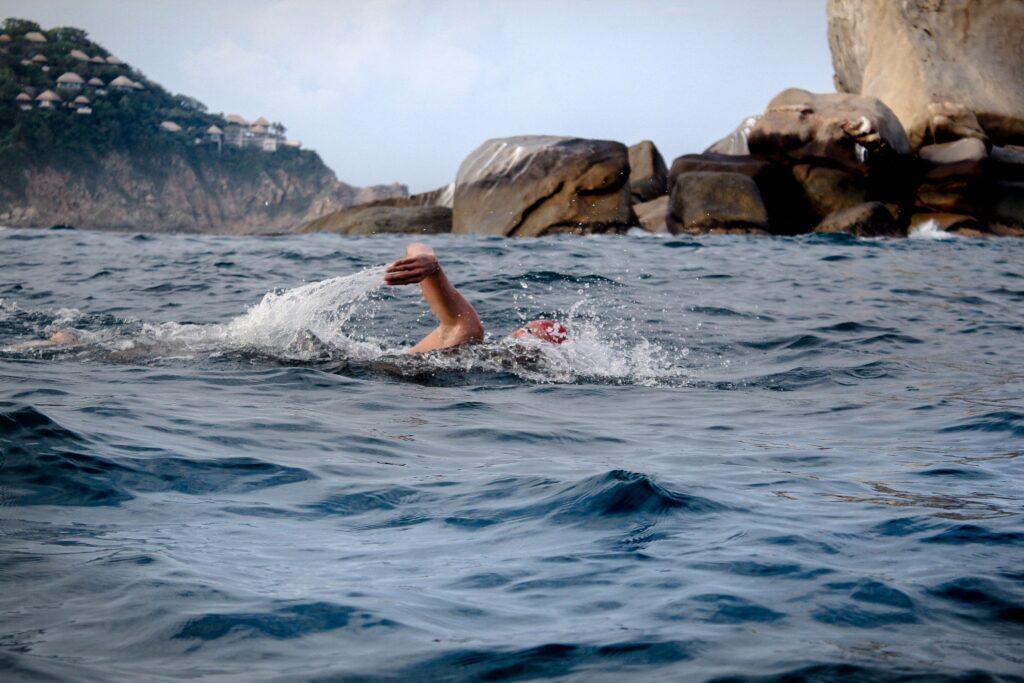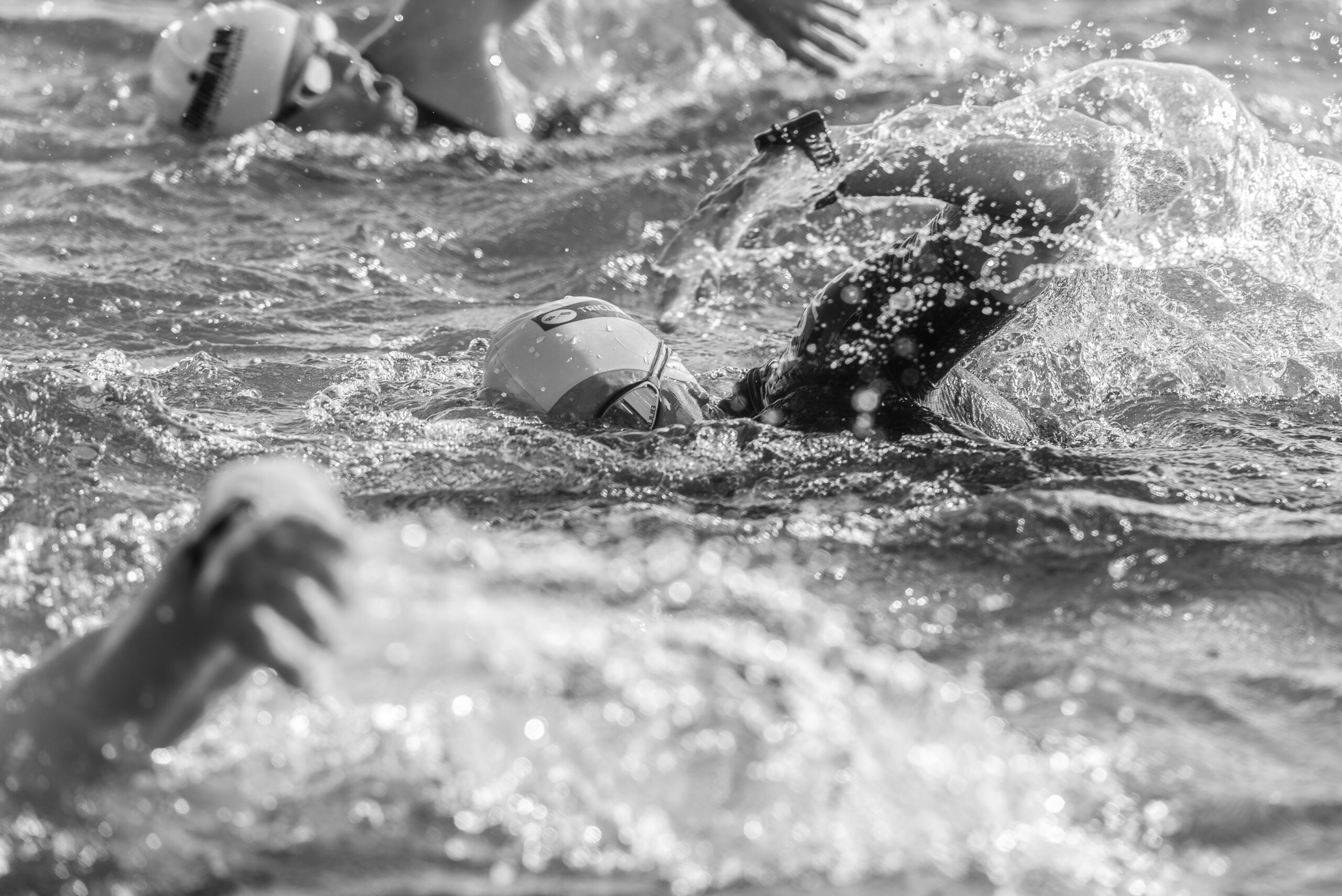As most swimming pools are closed for the next few months we are limited in our ability to train our swim. Luckily the weather is now starting to make open water swimming a realistic option. While the water temperatures are low it can be hard to get any real quality from these sessions. As it has become a bit warmer the potential to get a productive swim session in has increased significantly.
Many of us rely on the pool to develop our swimming and in some cases the prospect of open water is quite frightening. Pool swimming allows for consistent conditions which allow us to isolate and develop technique with our swimming. Pool lengths also give us something fixed from which we can prescribe times and paces etc. Without a doubt, the swimming pool allows us to be quite measured and specific with our swim training.
It is going to be a challenge to achieve the same sort of sessions in open water as you can in the pool. Simply transferring sessions across and trying to recreate them will be difficult in most cases. Despite this, there is plenty that can be achieved from training in the open water. The approach to training needs to be adjusted to reflect the different opportunities open water presents.
Below are some of our tips to implement an effective swim plan using the open water.
- Endurance sets
Open water has less defined distances so pacing individual sets is challenging. For most of us these timed sets make up the most of our regular pool based training. Long distance swimming isn’t very popular for most in a pool as it’s boring and gives little feedback in terms of pace etc. This does not make long sets any less effective, but less popular. A steady block of 30 minute swimming can be very effective in building sustainable swim speed and efficiency. Much like long run or bike sessions, the sustained effort helps build stamina and economy of movement. Longer steady duration swimming can easily be used effectively in a programme and is perfect for open water training.

- Skill swimming
Many of us view drills as essential for swimming but need extra equipment to keep variety in our drills. Open water provides more variety than a pool ever will. Wave height and orientation, wind, sun orientation, current and even salt or fresh water differences will alter our stroke. Swimming in different conditions helps us develop a feel for speed in different conditions. We spend so much time developing this in a pool and then go to race in open water and that feel is completely alien to us. Swimming in different conditions and experimenting with breathing and hand placement etc. will all help us adapt to varying conditions faster than those who never leave the pool.
- Strength
Waves and wetsuits definitely require more muscle force at times. Swimming in choppier water can help develop a powerful stroke that helps us pop through waves that we don’t experience in the pool. Swimming on a choppy day can promote quite a bit of strength improvement in the relevant movement patterns. As long as conditions are safe enough to venture out in, some chop and waves can really teach you to swim with more power.
- Sighting
Swimming in a pool and practicing sighting is a great way to develop the skill. Swimming in open water is the skill in action. Small things like the sun and waves can make it very challenging to sight turning marks. Practicing this regularly helps the skill massively. It will yield more improvements to your racing performance than flip turns in the pool ever will.
- Confidence
This is perhaps the biggest factor open water swimming will help. A pool is a comfortable environment; it is also very familiar. Everyday the same venue; open water will be different. This constantly varied environment, at first can be very challenging. After a while the challenges become familiar, you become more flexible to them and you will desensitize to the feeling of chaos that might come with them. Big swell can be extremely disorientating and frightening. Regular exposure to varying conditionings can help develop confidence and reduce the feeling of being overwhelmed by unfamiliar conditions. This can help get you off to a faster more confident start in races.

- Feeling speed
In a pool we have consistent conditions and a pace clock. It is very easy to get an external measure of speed. We rely on the clock to tell us if we are fast enough. Many of us never really develop a feel for speed. The absence of a clock and the varying conditions of open water put more emphasis on us to feel for what is fast. Getting a good sense of momentum in the water helps us to adapt to new conditions. Many try to recreate a perfectly developed style from the pool in the ocean. Let’s say we breathe to our right every second stroke and we are fast doing this. Suddenly, we are racing at a venue where the waves crash onshore and come from our right. Every other time we lift our head to breathe we will get a mouth full of water and no breath. This is massively disruptive to our stroke and we could drag to a halt. Simply switching to breathe to the left and shield our mouth from the waves can be the simple fix. Learning to switch things and keep moving quickly is a powerful skill to have when racing.
If you are shy about open water swimming it is important to know that you can develop confidence with regular exposure. Use common sense to make the most of things.
- Don’t swim in conditions which you know you are not able for.
- Swim with friends so you always have company and help if you need it.
- Use a floating buoy so you can be seen and have an emergency float if you need it.
- Do your homework on the venue. Know when the tide is flowing, are there rip currents, which wind direction will blow you onshore vs. out to sea etc.
- Ask locals about the venue as they generally have some pretty helpful tips.
If you are concerned with how to get back swimming using open water sessions or need some assistance organizing your training, don’t hesitate to contact us.
Make sure to sign up to our mailing list to stay up to date with our training guides and information.
[yikes-mailchimp form=”1″]
